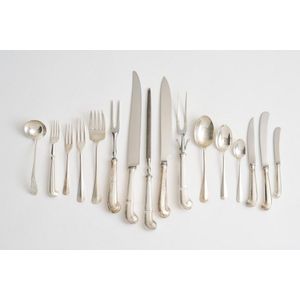Stieff & Tiffany Sterling Silver Flatware Set for Colonial Williamsburg
An American sterling silver flatware service by The Stieff Company Baltimore for Colonial Williamsburg and Tiffany & Co., 20th century, A 'Queen Anne' setting for twelve comprising; dinner, forks and knives, starter forks and knives, dessert and teaspoons, butter knives with two matched side knives, eight spare side knives, one ladle, serving fork and spoon and carving set matched with Tiffany & Co blade Sterling carving three piece set and three English silver pistol grip forks by Crichton Brothers, London 1931, (105 pieces), total weight: 2570 grams
You must be a subscriber, and be logged in to view price and dealer details.
Subscribe Now to view actual auction price for this item
When you subscribe, you have the option of setting the currency in which to display prices to $Au, $US, $NZ or Stg.
This item has been sold, and the description, image and price are for reference purposes only.
- Flatware - An alternative name for items of cutlery, principally knives, forks and spoons, now generally used to describe sets of these implements. Nowadays it is mostly used when describing cutlery made of silver and silver plate.
It is less frequently used to describe all "flat' items of tableware, so that as well as cutlery the definition includes plates. - Pistol Grip - Usually found on knives, and in use from about 1730, the pistol grip handle tapers out from the blade toward the end of the implement, and then curls in the shape of the truncated handle of an early pistol.
The grip is seen occasionally on forks, and also used to describe the handles on an urn where the handle rises up from the body of the urn towards the top, but turns down before meeting the neck, leaving a gap between the neck and the handle - Sterling Silver - Sterling silver is a mixture of 92.5% pure silver and 7.5% of another metal, usually copper. Fine silver is 99.9% pure silver, and is relatively soft and the addition of the very small amount of copper gives the metal enough strength and hardness to be worked into jewellery, decorative and household objects.
- Marrow Spoon - A spoon with a long handle and a narrow scoop shaped bowl, used to scoop and eat marrow from the hollow centre of roasted bones. Some marrow scoops are double ended with a different shaped bowl at each end.
This item has been included into following indexes:
- American / United States silver - silver flatware, cutlery and accessories 119
- butter knife / knives - silver items 190
- carving knife / knives - silver items 66
- silver cutlery / flatware, patterns
- silver cutlery / flatware, settings - unboxed 1,448
- Tiffany & Co. (United States) - silver, maker or retailer 84
